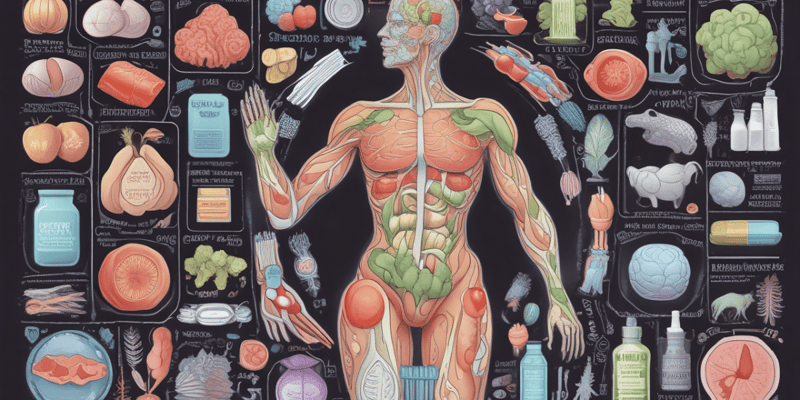Questions and Answers
Which of the following vitamins is NOT stored in the body?
Vitamin C
What is the primary function of iodine in the body?
Synthesizing thyroid hormones
What is the net ATP yield from the complete oxidation of one glucose molecule in cellular respiration?
36 ATP
Which of the following stages of metabolism involves the breakdown of complex molecules into simpler ones?
Signup and view all the answers
What is the primary function of electrolytes like sodium and chloride in the body?
Signup and view all the answers
What is the process by which glucose is broken down into pyruvate?
Signup and view all the answers
What is the primary reason why protein is used as fuel in the body?
Signup and view all the answers
What is the term for the breakdown of protein to form urea, which is then released from the body in urine?
Signup and view all the answers
What is the role of anabolic hormones in protein synthesis?
Signup and view all the answers
What is the characteristic of water-soluble vitamins?
Signup and view all the answers
What is the term for the state in which the rate of protein synthesis is greater than the rate of protein breakdown?
Signup and view all the answers
What is the role of vitamins in the body?
Signup and view all the answers
What is the primary function of soluble fiber in the body?
Signup and view all the answers
Which of the following is NOT a function of lipids in the body?
Signup and view all the answers
What is the difference between complete and incomplete proteins?
Signup and view all the answers
What is the primary function of prostaglandins in the body?
Signup and view all the answers
What is the primary use of glucose in the body?
Signup and view all the answers
What is the function of cholesterol in the body?
Signup and view all the answers
What is the primary function of magnesium salts in bone?
Signup and view all the answers
What is the net result of the catabolism of glucose in cellular respiration?
Signup and view all the answers
Which of the following minerals is essential for oxygen binding to hemoglobin?
Signup and view all the answers
What is the primary function of iodine in the body?
Signup and view all the answers
What is the term for the biochemical reactions inside cells involving nutrients?
Signup and view all the answers
Which of the following stages of metabolism involves the synthesis of lipids, proteins, and glycogen?
Signup and view all the answers
What is the primary function of glucose in neurons and RBCs?
Signup and view all the answers
Which of the following is a function of phospholipids in the body?
Signup and view all the answers
What is the role of omega-3 fatty acids in the body?
Signup and view all the answers
What is the primary function of cholesterol in cell membranes?
Signup and view all the answers
What is the characteristic of insoluble fiber in the diet?
Signup and view all the answers
What is the primary function of proteins in the body?
Signup and view all the answers
Which of the following hormones accelerates protein synthesis?
Signup and view all the answers
What is the primary consequence of inadequate caloric intake on protein synthesis?
Signup and view all the answers
What is the role of intrinsic factor in vitamin absorption?
Signup and view all the answers
What is the term for the state in which the rate of protein breakdown exceeds the rate of protein synthesis?
Signup and view all the answers
What is the function of vitamins in the body?
Signup and view all the answers
What is the consequence of deamination of protein?
Signup and view all the answers
What is the consequence of a negative nitrogen balance in the body?
Signup and view all the answers
Why are proteins not stored in the body?
Signup and view all the answers
What is the role of anabolic hormones in protein metabolism?
Signup and view all the answers
What is the term for the state in which the rate of protein synthesis equals the rate of protein breakdown?
Signup and view all the answers
What is the primary function of vitamins in the body?
Signup and view all the answers
What is the consequence of inadequate caloric intake on protein synthesis?
Signup and view all the answers
What is the term for the breakdown of protein to form urea, which is then released from the body in urine?
Signup and view all the answers
What is the characteristic of water-soluble vitamins?
Signup and view all the answers
What is the role of the 'all-or-none' rule in protein synthesis?
Signup and view all the answers
What is the function of hormones in protein metabolism?
Signup and view all the answers
Study Notes
Nutrition and Metabolism
- Nutrients: substances in food that promote normal growth, maintenance, and repair
- Major nutrients: carbohydrates, lipids, and proteins
- Other nutrients: vitamins, minerals, and water
Carbohydrates
- Dietary sources: starch, sugars, insoluble fiber, and soluble fiber
- Uses: glucose is the fuel used by cells to make ATP; excess glucose is converted to glycogen or fat and stored
- Importance: neurons and RBCs rely almost entirely upon glucose
Lipids
- Dietary sources: triglycerides, cholesterol, and essential fatty acids (Omega 3's and Omega 6's)
- Essential uses: help absorb fat-soluble vitamins, major fuel of hepatocytes and skeletal muscle, and phospholipids are essential in myelin sheaths and all cell membranes
- Functions of fatty deposits: protective cushions, insulating layer, and concentrated source of energy
- Regulatory functions of prostaglandins: smooth muscle contraction, control of blood pressure, and inflammation
Proteins
- Dietary sources: complete proteins (eggs, milk, fish, and most meats), incomplete proteins (legumes, nuts, and cereals)
- Importance: production of hormones, enzymes, clotting factor, and antibodies; formation of hemoglobin; structural materials
- All-or-none rule: all amino acids needed must be present for protein synthesis to occur
- Adequacy of caloric intake: protein will be used as fuel if there is insufficient carbohydrate or fat available
- Nitrogen balance: rate of protein synthesis equals the rate of protein breakdown in a healthy body
Vitamins
- Organic compounds crucial in helping the body use nutrients
- Most function as coenzymes
- Two types: water-soluble vitamins (B complex and C) and fat-soluble vitamins (A, D, E, and K)
- Vitamins A, C, and E act as antioxidants
Minerals
- Seven required in moderate amounts: calcium, phosphorus, potassium, sulfur, sodium, chloride, and magnesium
- Others required in trace amounts
- Work with nutrients to ensure proper body functioning
- Examples: calcium, phosphorus, and magnesium salts harden bone; iron is essential for oxygen binding to hemoglobin; iodine is necessary for thyroid hormone synthesis; sodium and chloride are major electrolytes in the blood
Metabolism
- Biochemical reactions inside cells involving nutrients
- Two types of reactions: anabolism (synthesis of large molecules from small ones) and catabolism (hydrolysis of complex structures to simpler ones)
- Cellular respiration: catabolism of food fuels and capture of energy to form ATP in cells
- Stages of metabolism: digestion, absorption, and transport to tissues; cellular processing; and oxidative breakdown of intermediates into CO2, water, and ATP
- Pathways of cellular respiration for carbohydrate metabolism: oxidation of glucose (C6H12O6 + 6O2 → 6H2O + 6CO2 + 36 ATP + heat)
Studying That Suits You
Use AI to generate personalized quizzes and flashcards to suit your learning preferences.
Description
Test your knowledge of nutrition and metabolism, including the different types of nutrients, their dietary sources, and their functions in the body.




